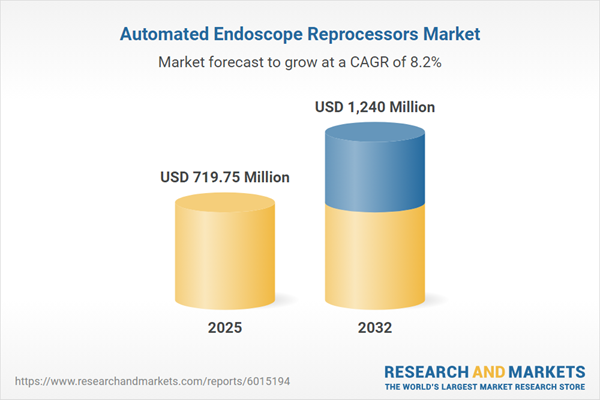Speak directly to the analyst to clarify any post sales queries you may have.
The Automated Endoscope Reprocessors Market empowers healthcare executives with targeted intelligence to enhance infection prevention strategies, ensure regulatory compliance, and guide adaptive procurement across diverse care environments.
Market Snapshot: Automated Endoscope Reprocessors Market Trends and Growth
The global Automated Endoscope Reprocessors Market is entering a period of steady expansion, forecasted to grow from USD 664.79 million in 2024 to USD 719.75 million in 2025, with a projected compound annual growth rate (CAGR) of 8.16% and an expected market value of USD 1.24 billion by 2032. This growth is driven by the increasing number of endoscopic procedures, heightened infection prevention standards, and substantial healthcare infrastructure investments worldwide. Evolving regulatory demands are also prompting the adoption of next-generation reprocessing technologies and digital workflow solutions. As a result, industry rivalry intensifies, with providers in both established and emerging regions demanding more dependable and advanced reprocessing systems. A greater focus on efficient supply chains and procurement agility characterizes market strategies, supporting the adoption of flexible and responsive solutions aligned with global healthcare benchmarks.
Scope & Segmentation: Product and Market Overview
- Product Range: Consumables, accessories, and customizable reprocessing systems—offered in both integrated and standalone formats—enhance operational flexibility for a variety of hospital and clinic workflows.
- Technology Options: High-level disinfection and sterilization are achieved using high temperature methods like steam, as well as low temperature processes such as ethylene oxide, hydrogen peroxide, and ozone to meet rigorous infection control protocols.
- End User Profiles: Hospitals, ambulatory surgical centers, and specialty clinics adopt endoscope reprocessing equipment tailored to their unique throughput, workflow, and procedural needs.
- Endoscope Types: Dedicated systems for bronchoscopes, gastrointestinal, and urology endoscopes ensure precise hygiene management across multiple medical specialties.
- Distribution Channels: Both direct and distributor-led procurement structures help healthcare providers maintain oversight of purchasing and streamline supply logistics for continuity of operations.
- Region Analysis: Market coverage includes the Americas, Europe, Middle East & Africa, and Asia-Pacific, with each region shaped by specific compliance frameworks, care standards, and distinct rates of technology adoption, impacting how reprocessing systems are implemented.
- Key Companies: Olympus Corporation, STERIS plc, Cantel Medical Corp., Getinge AB, Belimed AG, Steelco S.p.A., Wassenburg Medical B.V., Soluscope S.A.S., Nikken Medical Co., Ltd., and Metrex Research LLC lead sector advancements and access globally, influencing product innovation and availability.
Key Takeaways for Senior Decision-Makers
- Real-time digital monitoring and remote diagnostic capabilities increase workflow transparency and support efficient infection prevention oversight, directly addressing operational and patient safety standards.
- Modular equipment architectures and upgradeable reprocessing components equip healthcare providers to rapidly adapt to evolving industry standards and integrate new technologies.
- Emphasis on digital traceability and comprehensive audit trails strengthens compliance with internal and external reporting demands, supporting both accountability and risk mitigation.
- Reliable after-sales services, such as rapid parts replacement and predictive maintenance programs, are essential in minimizing delays and maintaining the integrity of endoscope reprocessing schedules.
- Compact, high-output reprocessing units benefit ambulatory and space-constrained facilities by enabling fast turnaround and optimizing equipment utilization.
- Regional differences in procurement and compliance necessitate adaptive sourcing strategies to help healthcare organizations maintain consistent access and meet global standards.
Tariff Impact: Navigating the 2025 U.S. Tariff Landscape
Recent increases in tariffs on U.S. imports of automation components are prompting shifts in the automated endoscope reprocessor segment’s manufacturing economics. In response, leading industry players are diversifying their supplier networks, updating sourcing agreements, and boosting domestic investments. These initiatives strengthen supply chain resilience, promote ongoing technology access, and help reduce exposure to international sourcing risks.
Methodology & Data Sources
This report leverages a mixed-methods research framework, integrating comprehensive secondary data analysis with insights from discussions with industry executives and clinical practitioners. A multi-stage validation process ensures findings are directly relevant, actionable, and reliable for senior healthcare decision-makers evaluating the automated endoscope reprocessors market.
Why This Report Matters for Senior Stakeholders
- Offers strategic guidance to anticipate regulatory developments, foster digital transformation initiatives, and support optimal procurement decisions within increasingly complex healthcare environments.
- Delivers approaches for enhancing endoscope reprocessing workflow efficiency and lifecycle management, balancing the critical needs of safety, operational adaptability, and cost-effectiveness.
- Equips executives with regional and global market perspectives to strengthen supply chain continuity and guide informed growth and risk mitigation planning.
Conclusion
This market analysis supports healthcare leaders in aligning procurement, compliance, and operational strategies to overcome reprocessing challenges and achieve organizational goals for sustainable advancement.
Additional Product Information:
- Purchase of this report includes 1 year online access with quarterly updates.
- This report can be updated on request. Please contact our Customer Experience team using the Ask a Question widget on our website.
Table of Contents
3. Executive Summary
4. Market Overview
7. Cumulative Impact of Artificial Intelligence 2025
Companies Mentioned
The companies profiled in this Automated Endoscope Reprocessors market report include:- Olympus Corporation
- STERIS plc
- Cantel Medical Corp.
- Getinge AB
- Belimed AG
- Steelco S.p.A.
- Wassenburg Medical B.V.
- Soluscope S.A.S.
- Nikken Medical Co., Ltd.
- Metrex Research LLC
Table Information
| Report Attribute | Details |
|---|---|
| No. of Pages | 193 |
| Published | October 2025 |
| Forecast Period | 2025 - 2032 |
| Estimated Market Value ( USD | $ 719.75 Million |
| Forecasted Market Value ( USD | $ 1240 Million |
| Compound Annual Growth Rate | 8.1% |
| Regions Covered | Global |
| No. of Companies Mentioned | 11 |









